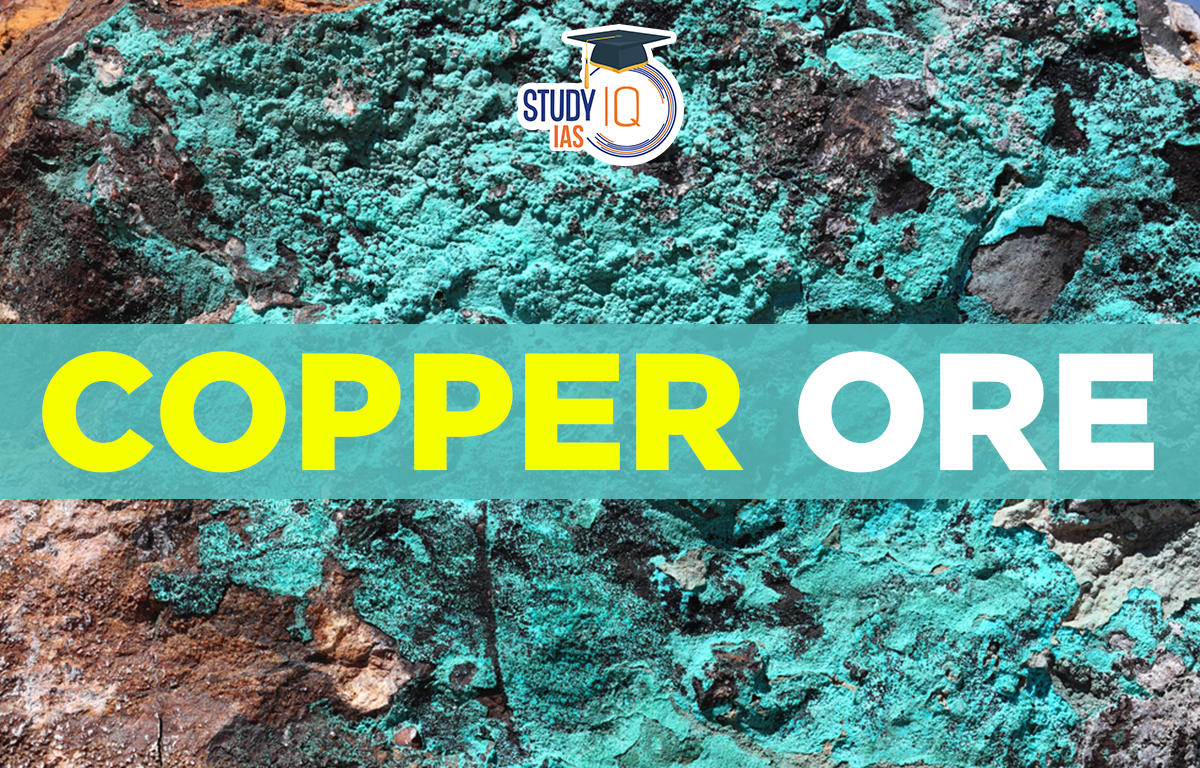Table of Contents
Copper Ore
Copper ore can be found in both ancient and younger rock formations as veins and bedded deposits. Mining copper is an expensive and time-consuming process because most copper ores contain only a trace amount of metal. Copper is a soft brown metal found in igneous and metamorphic rocks. There are three primary Copper Ores viz. Chalcopyrite, copper sulfide, and basic carbonates. During the extraction of copper from ores, a few other minerals and metals, such as gold, silver, lead, zinc, etc., are also extracted. Copper is resistant to corrosion and does not rust.
Copper is a good electrical conductor and is ductile (able to be drawn out into a thin wire). It is a vital metal used in the automotive and defence industries, as well as in the electrical industry for the manufacture of wires, electric motors, transformers, and generators. To make stainless steel is alloyed with iron and nickel. Morel metal is created by alloying copper with nickel. Duralumin is a metal alloyed with aluminium. It is known as ‘brass’ when alloyed with zinc, and ‘bronze’ when alloyed with tin.
Read about: Iron Ore
Copper Ore Distribution in India
1. Chilpi Series
It encompasses parts of Madhya Pradesh’s Balaghat and Chhindwara districts. Quartzite, copper-pyrite, mica schist, and marble comprise the series. The copper from this series is used at the Malanjkhand Copper Plant.
2. Ghatsila
This copper smelting plant is located in Jharkhand. It is a refinery that uses electrolysis. It produces brass sheets. It also obtains gold, silver, and nickel from copper processing.
3. Khetri
It is an integrated copper mining and ore refining plant in Rajasthan’s Jhunjhunu District. It was founded in 1967. It also gets copper ore from Madhya Pradesh’s Malanjkhand copper mines. There is also a sulfuric acid plant and a fertiliser plant.
Read about: Energy Resources
4. Malanjkhand
Malanjkhand is an open cast copper mine in Madhya Pradesh’s Balaghat District. In Malanjkhand, a copper plant has been established. The copper ore is also sent to Rajasthan’s Khetri Copper Plant.
5. Rakha Initiative
The Rakha Copper Plant is located in the Rakha District of Jharkhand’s Singhbhum. It obtains copper ore from the Rakha mines.
6. Tajola
The Tajola Copper Plant is located in the Maharashtra town of Raigadh. Copper cathodes were imported for the plant. It produces copper rods.
Read More: Manganese Ore
Copper Ore Distribution in World
Chile is the world’s largest copper producer, followed by Peru. Other copper-producing countries include the USA, Canada, and Australia.
| Country | Areas |
| Chile | Copper Mountain of Chuquicamata, El Teniente, Rio Blanco, Braden |
| Peru | Moquegua region |
| USA | Arizona, Globe, Miami, Nevada, New Mexico |
| Canada | Sudbury, Lynn Lake, Sheridon |
| Sweden | Falun Mine |
| Germany | Mansfield |
| CIS | Degtyarsk, Kazakhstan |
| Australia | Mt Isa, Mt. Morgan |

Read about: Chromium Ore
Uses of Copper Ore
- Copper is a good conductor of heat and electricity. It is widely used in electrical works for making wires, generators, transformers, electronics, etc.
- Due to its high malleability, copper is commonly used in the metallurgical industry. It is used to make cables, fittings, and parts for automobiles.
- It is used to make many alloys. When combined with tin, it produces bronze. When it is mixed with gold, it produces guinea gold. With zinc, it produces brass, and with nickel, it produces monel metal. When copper is mixed with aluminium, it produces duralumin. An alloy is a combination of a metal with at least one other metal or nonmetal.
Read More: Cobalt Ore
Copper Ore Properties
- Copper ore is found in a variety of mineral forms, such as sulfides, oxides, and carbonates. The copper content in copper ore can vary from less than 1% to over 50%.
- Copper ore has a moderate hardness, typically ranging from 3 to 4 on the Mohs scale.
- The specific gravity of copper ore ranges from 2.5 to 3.5, depending on the type and mineral content.
- Copper ore is a good conductor of heat and electricity.
- Copper ore is not highly reactive, but can react with strong acids and oxidizing agents.
- Copper ore can range in colour from metallic red to black, depending on the type and mineral content.
- Copper ore is soft and malleable and can be easily bent or shaped without breaking. It also has high ductility, meaning it can be easily drawn into wires or sheets.
Copper Ore UPSC
India is unlucky in terms of copper reserves and production. Her total in-situ reserves are estimated to be around 712.5 million tonnes, which equates to 9.4 million tonnes of metal content. India is a poor country in terms of copper reserves and production. India has low-grade copper ore (less than 1% metal content) compared to the international average of 2.5 per cent.
Major copper ore deposits can be found in the districts of Singhbhum (Jharkhand), Balaghat (Madhya Pradesh), and Jhunjhunu and Alwar (Jharkhand) (Rajasthan). India is a poor country in terms of copper reserves and production. India has low-grade copper ore (less than 1% metal content) compared to the international average of 2.5 per cent.
Read More: Types of Resources





















 WhatsApp
WhatsApp